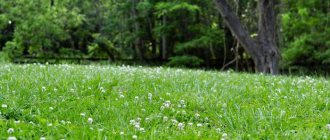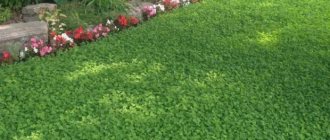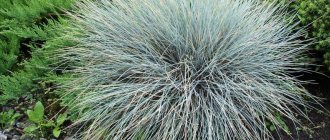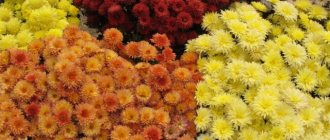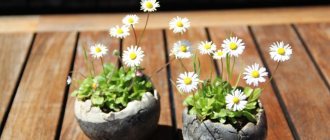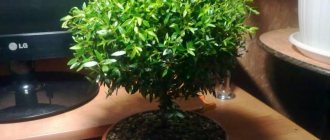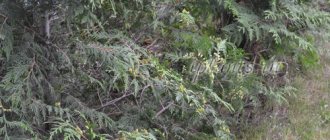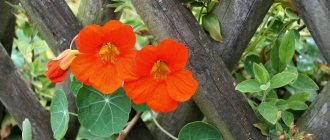What kind of plant is this?
Clover is a small perennial plant. Belongs to the legume family. It has delicate bright green leaves of an original shape. There are 3 leaves per stem, which is why the plant is called “shamrock”. Flowers are collected in inflorescences similar to the shape of a ball. They can be white, pink, red.
The plant is considered a honey plant, it is fragrant, bees live near it constantly. Clover is unpretentious and grows on clay, sandy, acidic and neutral soils. It can be in sunny open meadows. It does not need frequent watering, and this plant tolerates winters well.
If the lawn is damaged in severe frost, it should not be replanted; in a short time, the white clover on the lawn will grow on its own. And in dark areas and in the presence of a large amount of moisture, the plant deteriorates. If you choose clover for your lawn, it will bloom from late spring to mid-autumn. But in the year of planting it does not bloom; this must be expected for the next season.
Clover lawn from scratch, its advantages and disadvantages
How to make a lawn from clover and is it worth doing at all?
Articles about lawns are usually not interesting to read; they are all kind of dry in accounting. “Remove 10 centimeters of turf, put 10 centimeters of turf. Pour 100 grams per 100 square decimeters”... No, for people with creative ambitions this is all no good?
Let me start by saying that I am by no means a professional when it comes to lawns. If I were a professional, I would write about 10 centimeters of turf. And in general, I never wanted, never made or saw a lawn. Well, there are many men who dream of a lawn as some kind of symbol of home well-being or something like that. And for sure, there are many women who dream of a lawn. But all my life I have been indifferent to lawns.
I had to do the lawn. Since there is a certain amount of empty land around the newly built house... After construction, something incomprehensible began to grow there - prickly thistle, quinoa, some cereals the size of a man... It is clear that it cannot be left like this - or everything must be concreted/asphalted, which is unacceptable for me . Or a lawn. The lawn is acceptable to me, although I have never done it.
Neighbors again. Then you’ll go to one. then to another. They proudly show off their lawns. I look... well, grass and grass, shaved like a beaver. Business. “No, I’ll be original - I’ll make a lawn from clover,” I decided, because I had a pack of white clover seeds lying around for an area of 500 square meters. (For comparison, the cost of lawn mixtures for the same area would cost 10 times more.)
But before sowing clover, it was necessary to give the surrounding soil at least some semblance of flatness and add at least a small fertile layer.
For leveling, about 50 cubic meters of sand were used and the same amount of black earth was dumped on top. The result was a relatively fertile layer of about 10 centimeters. The workers hastily leveled it out for me with a rake. Finally, before leaving, the last and most important worker revealed a professional secret (almost in a whisper, when the rest of his colleagues were already sitting in the running car, ready to leave) - it turns out that before sowing the grass, all this black soil should also be compacted . Somehow I didn’t attach much importance to these words - well, it will be necessary - we’ll compact it.
It started to rain... The black soil somehow compacted itself in some places, but not in others. It became clear that the option of “scattering the seeds now and waiting” would not give a very good result.
I had to go online and read about trampling and compacting lawns. There were all kinds of funny ways there. And pour water into the barrel and roll it. And take a sheet of plywood, lay it on the ground and jump on this plywood, preferably with a family of at least three people. Special rollers for lawns were also considered.
I liked the idea with the skating rink. I went to gardening stores. In one of them there was a skating rink, weighing three hundred kilograms and the size of half a car. In another they said that it was not yet the season, but they would deliver it soon... And it was already the month of May. There was no point in waiting until their season started.
Well, then I would have used the method with an improvised skating rink - half a pole from high-voltage lines was lying on the site. What that pillar was doing there, I don’t know. But I adapted it precisely as a skating rink. Drive - foot. That is, you walk and push this log with your foot, and it rolls for some distance. We rolled the log leisurely for a week, one at a time, as long as anyone wanted. They compacted it somehow, not perfectly of course. But I didn’t have the task of doing it perfectly.
As for the “sowing” itself, everything was simple with it. He picked up a bag of clover seeds and walked around, sprinkling them in a sweeping manner. Then I found a few more packets of grass seeds in the bins, and scattered them here and there too—not to let the goodness go to waste. I also sowed alfalfa along the fence for added beauty. It's a lawn! I walked over the top with a log and rolled out the seeds...
Sowing lawn grass, even clover, must be done before the rains. To do this, we look at the weather forecast, and if no precipitation is expected, then we will have to water, otherwise nothing good will grow.
In May it was not very damp, but it still rained sometimes. The clover and some of the grass came up quite quickly, and I periodically walked and sometimes rolled this thing with a log. When the places where bald patches had formed became clearly visible, he sowed more grass. And clover.
Based on numerous recommendations I read on the Internet, I knew that the grass should be mowed when it reaches a size of about 10 centimeters. But firstly, I had no time, and secondly, I was lazy. And thirdly, I didn’t have a lawnmower. There was a trimmer, like a brushcutter, with a fishing line. I used it to mow the second part of the area, where the lawn had not yet been planned, and is not planned, there we have something like a natural meadow.
So, due to the lack of a mower and laziness, until August I did not mow the clover at all. Well, I didn’t mow the grass either.
Pros and cons of a clover lawn.
By August, the clover had grown so much that it became obvious that it was necessary to mow this thing down. I must say that I hoped that the white creeping clover would form a beautiful, even rug, no more than 10 centimeters in height. The peaceful buzzing of bees, the emerald green of clover leaves and the blue sky, ah-ah... Something like this should have happened according to my calculations.
But we liked the clover on our site. I liked it very much. The white creeping clover was a great success, it was 30 centimeters tall, bloomed profusely and was not easily mowed with a trimmer and fishing line, because it was always damp in the depths.
In addition, if it was not damp, but dry and hot, then the clover became sluggish and fell down with all its 30 centimeters, so again it was not easy to mow it.
Another disadvantage of such mowing with a fishing line was the rather obscene appearance of the improvised lawn - brown dry leaves, stalks and other remains of clover look untidy for several days after mowing. This is probably the main disadvantage of a clover lawn. Although, already three days later, the clearing was filled with fresh, bright leaves.
- The second disadvantage is that if you have slopes on your site, then keep in mind that mown clover becomes very slippery.
- The third minus is quite relative; for some it may be a plus. Keep in mind that this is creeping . He quickly covers up all sorts of bald spots, but at the same time he strives to crawl out wherever he was not invited - into the beds, flower beds, etc.
- The fourth disadvantage is that by autumn there were a lot of snails and slugs in the clover. But mowing in wet weather is bad.
Now let's look at the advantages of clover as a lawn grass.
- Clover forms a very dense, well-knit turf.
- If mowed infrequently and allowed to bloom, clover provides food and attracts bees, bumblebees and other pollinators to the area.
- The clover lawn is actually beautiful. But not for everyone.
- Clover is unpretentious, germinates quickly and grows quickly.
- Clover is resistant to trampling. I couldn’t make the path, no matter how hard I tried.
- Clover enriches the soil with nitrogen. And the mulch from mowed clover turns out wonderful.
Our sea pig Gavryusha had a very positive attitude towards planting clover. All summer he devoured huge amounts of clover with great pleasure, looked askance at all other vegetables and ate them reluctantly.
Conclusions. It’s too early to call what I got a lawn. But if you compare it with what happened before, it’s not bad at all. Next year I will try to convert part of the lawn with clover into a regular grass lawn. With grass there are fewer snails. But I’m not going to give up clover completely.
By the way, in September I finally bought a normal gasoline lawn mower and tried it on clover. It turned out much faster and better than with a trimmer.
Next summer I plan to transform the existing lawn into something much more deserving of the name “Lawn”.
Addition from 2013.
See comment and photo here.
Addendum dated June 6, 2015.
This year I was absent for almost the entire month of June and therefore did not mow the lawn. I thought that upon arrival I would see a terrible picture of total desolation and intoxication. But nothing happened, the lawn was quite good, and the clover finally bloomed this year (the summer was dry and cool, which is why it bloomed so late). So for those who don’t like to mow often, clover is just what you need!
Please enlarge the photos, they look good
ps Thank you for your feedback on the material, may your clover lawns bring you joy!
Lawn Features
The lawn with white clover is called "Sloth". Reviews confirm that the plant is added to the grass mixture to soften the coating. This type of lawn is good for arranging children's lawns with slides, swings, benches and houses.
Creeping clover is a low-growing plant, so many gardeners do not prefer to cut it. But they tolerate haircuts well. The minimum recommended mowing height is 3-4 cm, and the maximum is 10-12.
What is the price?
We come to the most interesting thing - the cost of the lawn. Price 1 sq. meter is 2000 rub. If you order from 5 sq.m., this amount also includes the process of soil preparation, fertilizer, sowing and seeding 3 weeks after the start of work. Such a complex is a guarantee of a perfectly maintained plot of land throughout the warm season.
I also offer my clients seeds for planting. 1 kg of seed mixture costs 1000 rubles. This volume is more than enough to create 10 sq. meters of a dense, beautiful lawn, or maintaining the ideal condition of a plot of 4 sq.m. for 2-3 years.
Call us at the phone number listed below. We deliver high-quality lawn throughout Russia in the shortest possible time.
pros
Many summer residents prefer to decorate their plots with beautiful clover. This is evidenced by numerous reviews. But there are those who consider it a weed.
The benefits of a clover lawn are as follows:
- White clover looks very nice for a lawn. Reviews confirm its decorative appearance. Everything looks especially beautiful together with flowers planted in pots. A perfect combination with compositions and flower beds, peonaries and rose gardens, fountains, ponds, alpine slides and solitary plants. Clover perfectly decorates large and small areas.
- The green plant has powerful roots that crowd out various weeds. Because of such a powerful root system, it grows near banks, wastelands and on hillsides.
- Clover does not require special care. It also does not need cutting or watering.
- Clover supplies nitrogen to the soil thanks to the bacteria found in its rhizomes. When it is part of a lawn grass mixture and grows in an area with other cereals and flowering plants, it acts as a fertilizer and improves disease resistance.
- The lawn tolerates trampling well, making it ideal for picnics.
- Low cost of seeds.
The photo of the white clover lawn looks beautiful. Reviews from summer residents confirm the ease of maintaining the area.
Outdoor care
Creeping clover is an unpretentious plant, so it is very easy to care for. All you need to do is mow the lawns in time using a trimmer. As for watering, clover, in principle, has excellent precipitation. If the weather is very dry, you can lightly water the plant so that the greens are bright and juicy.
Clover has the amazing ability to independently produce nitrogen from its roots. Thanks to this property, you can significantly save on the purchase of various fertilizers.
Minuses
A clover lawn also has disadvantages:
- The territory looks attractive only during flowering, because then the inflorescences-balls, like beads, are scattered across the carpet. But after this, dried flowers make the appearance not entirely beautiful, even unkempt. It will be necessary to remove dried inflorescences.
- The lawn grows quickly, and therefore if the plant is in a grass mixture, then after some time it will dominate over the others.
- Clover has wet turf, which makes the surface slippery. It will be unsafe to play on it.
Experts advise purchasing white clover for the lawn at the initial stages of building a house. Reviews indicate that it will not allow weeds to grow. In addition, this allows you to fertilize the soil with nitrogen, and this is necessary for the subsequent planting of cultivated plants. Such renovation of the site will be required when engaging in beekeeping. Only then will it be impossible to walk on this territory.
How to plant Dutch clover
Dutch clover is one of the most common varieties of this plant, from which many varieties have been developed.
Clover should be planted at a temperature not lower than 10°C. This can be done from the beginning of May until the end of September.
In order for your clover lawn to look smooth and neat, you need to follow a few simple planting rules:
- If there was no rain shortly before sowing time and the soil is dry, then it should be well watered the day before.
- The seeds need to be deepened into the ground 1 - 2 centimeters.
- After sowing, you need to trample the soil so that the white clover seeds sprout evenly.
Seeds
Before planting white clover for the lawn (reviews confirm this), you need to buy high-quality seeds. It is advisable to purchase them in specialized stores. Such clover needs to be mowed in rare cases, since the variety is creeping and low-growing. If the covering has pink and red flowers, then the plant will be tall.
Ideal for sowing:
- White creeping - “dukhmyana”, “volat”, “sorceress”.
- Pink hybrid – “Tursky”, “daubyai”, “handsome”.
- Red meadow - “vichay”, “raya”, “maro”.
Nuances of sowing and planting
The area for laying the clover lawn must be dug up, ridding the area of weed roots. Next, compact the soil using a roller and level the surface. The nuances of organizing sowing work also include pre-sowing watering of the soil. For uniform sowing, it is recommended to mix the seeds with wet sand or sawdust. The seed is deepened by 0.5-1 cm, depending on the looseness of the soil, using a rake. It is also possible to lightly sprinkle the seeds with sand without covering them with a rake.
The timing of sowing low-growing creeping clover for lawns varies:
- in early spring, when the remaining snow melts, freezing at night into a thin ice crust, the seeds are sown “shard by shard”, laying them on the ice. With melt water, the seeds are gradually drawn into the ground;
- when the daytime temperature is established within +12°C, lawn clover seeds are sown shallowly in heated, moist soil;
- autumn sowing is carried out before the first ten days of September to ensure high-quality seedlings and rooting of plantings before frost
The pre-winter method of planting seeds for a clover lawn involves seedlings in early spring. For predicted results, the rate of seed material is doubled.
Arrangement
How to plant white clover for your lawn? Reviews say that any period of the year is suitable for this, except winter. The plant tolerates heat and drought well, but frost has a negative effect on it. If you want to sow seeds in the fall, you should do this 1.5 months before frost. This period is enough to prepare for winter and strengthen the roots.
The site is prepared in the spring. After the ground has warmed up, the area needs to be leveled. Weeds should be removed and the area should be covered with a hand roller. The seeds are mixed with sand or soil and scattered over the entire area. Peat or soil is poured on top. It is advisable to sow in moist soil.
The sown area is watered with a hose equipped with a spray nozzle. During the first week, the lawn should be watered, preferably in the evenings. The soil should not be dry, otherwise the crops will be uneven. If everything is done correctly, then green shoots will appear after 2 weeks.
The lawn needs to be watered every week. No feeding is required for it. If desired, it can be trimmed to give it a decorative and neat appearance. It is advisable to use a trimmer for cutting. With regular care, the surrounding area will always be attractive.
Main types
About 20 varieties are used in landscape design. They differ in height, color and decorative value. Used to create a flowering carpet on lawns and lawns. They look good among the stones of an alpine hill and rockery.
To avoid disappointment, you need to know in detail about the variety you are going to purchase.
meadow clover
Common wild species. The flowers are pink or reddish. Spreads across meadows, fields, mountains. Unpretentious and tenacious.
White clover (creeping)
The perennial plant is a creeping species. Spreads along the ground, stem length up to 40 cm. Leaves are round, triple. Tolerates trampling, frost, and drought. Blooms with white balls. A white clover lawn rises 10 cm from the ground, but in the wild it can grow up to 30.
Variety Atropurpurea
Artificially bred decorative appearance. The leaves are dark purple. The edge seems to be outlined with a green pencil. Loves sunny places. It is under the influence of bright light that it acquires its color. In the shade it will turn green and lose its originality. Leaves of three and four blades.
Variety Purpurascens
Designed for decorative flower beds. Four-leaved. Brown-red paint seemed to flow on each leaf, leaving the edges and veins a rich green. Quickly takes over the entire surrounding space.
Variety Good Luck
Interesting color of four leaves. In the center there is a brown spot with jagged edges and light brown streaks. Most of the leaf is green with light green veins.
pink clover
Blooms with pink and white balls. In terms of vitality, it is superior to the meadow variety. Unpretentious to high soil acidity. Loves moisture. The period of active flowering is from early summer to autumn. There are three leaves per stem.
Red clover
This is a bush up to 60 cm tall. The inflorescences are elongated, large, raspberry-red. The leaves are large, three-fingered. It begins to bloom continuously from the beginning of July. It spreads better by seeds. When you try to divide the bush, a fifth of it takes root. Wild species are protected by law.
